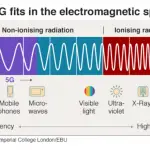In recent years, the use of infrared light has increased significantly, from medical and industrial uses to entertainment and home heating. However, with the rise of infrared technology comes an increased risk to humans, which must be taken into consideration before using or exposing yourself to infrared radiation. In this article, we will explore the potential risks of infrared to humans, and discuss how to safely use this technology.
Infrared radiation can pose health risks to humans. Prolonged exposure can cause burns and other serious skin damage. It can also cause long-term damage to the eyes and can increase the risk of certain forms of cancer. It can also dry out and irritate the airways, leading to difficulty breathing or asthma-like symptoms. People who are at a higher risk of developing health complications should take precautions when exposed to infrared radiation.

Contents
What are the Health Risks of Infrared Radiation to Humans?
Infrared radiation is a type of electromagnetic radiation that is invisible to the human eye and is emitted by all objects in the form of heat. The risks of infrared radiation to humans vary depending on the type and intensity of the radiation. Although infrared radiation is generally considered to be safe, it can still cause harm when exposed to high levels of radiation over a long period of time.
Infrared radiation is used in a variety of applications, including medical imaging, heat therapy, and communications. While the majority of applications use infrared radiation at a low enough level to be safe for humans, there are still a few potential health risks that should be taken into account. In this article, we will discuss the potential risks of infrared radiation to humans.
Risks from Long-Term Exposure
One of the most common risks of infrared radiation is long-term exposure. Prolonged exposure to infrared radiation can cause damage to the skin, as well as other organs. Exposure to infrared radiation can lead to burns, rashes, and other forms of skin irritation. It can also damage the eyes, leading to cataracts and other vision problems.
In addition, long-term exposure to infrared radiation can cause changes in the body’s temperature regulation. This can lead to an increase in body temperature and can lead to fever-like symptoms. Long-term exposure to infrared radiation can also lead to an increased risk of cancer.
Risks from Short-Term Exposure
Short-term exposure to infrared radiation can also pose a risk to humans. Short-term exposure to infrared radiation can cause a burning sensation on the skin, as well as irritation and redness. It can also lead to eye fatigue and headaches.
In addition, short-term exposure to infrared radiation can cause an increase in body temperature, leading to heat exhaustion and dehydration. It can also cause an increase in heart rate and respiration, leading to hyperventilation.
Risks from Inadequate Protection
Inadequate protection from infrared radiation can increase the risk of negative health effects. It is important to use protective equipment, such as goggles and gloves, when working with infrared radiation. It is also important to limit the amount of time spent near infrared radiation sources.
Eye Protection
When working with infrared radiation, it is important to wear protective eyewear. This can help to reduce the risk of eye fatigue, headaches, and cataracts.
Skin Protection
When working with infrared radiation, it is important to wear protective clothing, such as long sleeves and pants. This can help to reduce the risk of skin irritation, burns, and rashes.
Risks from Medical Applications
Medical applications of infrared radiation can also pose a risk to humans. Medical imaging, such as X-rays and CT scans, use infrared radiation to create images of the inside of the body. These images can be valuable in diagnosing and treating medical conditions, but they can also expose the patient to high levels of radiation.
X-Rays and CT Scans
X-rays and CT scans use high levels of infrared radiation to create images of the inside of the body. This radiation can be dangerous if not properly shielded, and can lead to increased risk of cancer.
Heat Therapy
Heat therapy uses infrared radiation to treat medical conditions. While this type of therapy is generally safe, it can pose a risk if used improperly. Too much heat can lead to skin irritation and burns, as well as other health risks.
Top 6 Frequently Asked Questions
What is Infrared Radiation?
Infrared radiation is a type of electromagnetic radiation with a wavelength that is longer than that of visible light. It is invisible to the naked eye and is produced by a variety of sources, including the sun, heaters, and infrared lamps. Infrared radiation is classified into three categories: near, middle, and far infrared. Near infrared has the shortest wavelengths and is closest to visible light, while far infrared has the longest wavelengths and is typically used in remote sensing.
How Can Infrared Radiation Affect Humans?
Exposure to infrared radiation can cause thermal burns, as well as damage to eyes, skin, and other tissues. Prolonged exposure to high levels of infrared radiation can also increase the risk of developing certain types of cancer. In addition, infrared radiation can cause vision problems, such as cataracts, and can also increase the risk of developing age-related macular degeneration.
What Are the Health Effects of Short-Term Exposure to Infrared?
Short-term exposure to infrared radiation can cause skin and eye irritation, as well as headaches and nausea. Prolonged exposure to infrared radiation can also damage the eyes and skin, leading to sunburn and other skin disorders.
What Are the Health Effects of Long-Term Exposure to Infrared?
Long-term exposure to infrared radiation can increase the risk of developing certain types of cancer, such as skin cancer. Prolonged exposure can also lead to skin damage, including premature aging and wrinkles. In addition, infrared radiation has been linked to an increased risk of developing eye diseases, such as cataracts and age-related macular degeneration.
What Are Some Ways to Reduce Exposure to Infrared Radiation?
There are several measures that can be taken to reduce exposure to infrared radiation. Wearing protective clothing and using sunscreen can help protect the skin from infrared radiation. In addition, it is important to avoid looking directly at sources of infrared radiation, such as the sun and infrared lamps. Finally, it is important to follow safety guidelines when using infrared devices, such as infrared cameras and heaters.
Are There Any Regulations Regarding Infrared Radiation?
Yes, there are regulations in place to protect people from the health effects of infrared radiation. The Occupational Safety and Health Administration (OSHA) sets limits on exposure to infrared radiation in the workplace. In addition, the Food and Drug Administration (FDA) regulates the use of infrared devices, such as infrared cameras and infrared lamps.
The Secret Reason Infrared Heat Can Heal Neck, Back, Shoulder, Hip Pain & More!
The risks of infrared exposure to humans can be serious and should not be taken lightly. Infrared radiation can cause skin and tissue damage, as well as long-term health risks. In some cases, prolonged exposure can even be fatal. For this reason, it is important to be aware of potential risks and take steps to protect yourself when working around infrared radiation. By understanding the potential dangers and knowing how to protect yourself and others, you can avoid the dangers of infrared radiation and stay safe.







